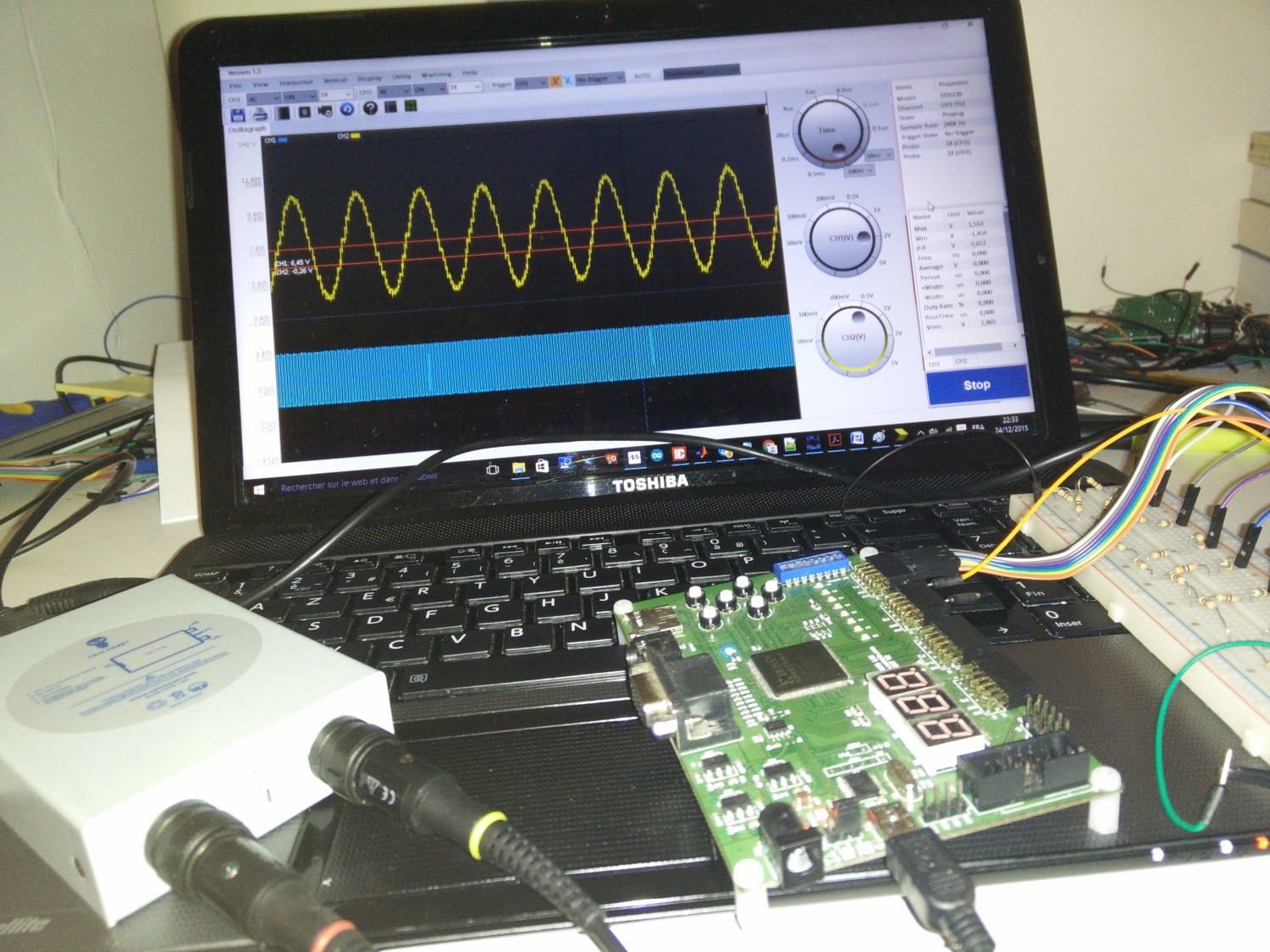
Objectifs du projet électronique
- Comprendre le principe de fonctionnement de la méthode utilisée
- Savoir comment coder un signal en virgule fixe sur N bits de taille M
- Savoir comment stocker un signal en virgule fixe sur la mémoire de FPGA
- Savoir comment générer une horloge d’échenillage à une fréquence fixe à partir d’une horloge Maitre
- Se familiariser avec un système multi processus
- Savoir comment concevoir sa propre Convertisseur D/A (DAC) de résolution R avec le réseau R/2R
- Savoir comment implémenter un code sur FPGA
- …
Principe de fonctionnement
Le circuit permet de générer trois signaux multiplexés en fonction du choix de l’utilisateur codés sur 8 bits (signal sinusoïdal, bruit ou la somme des deux). La fréquence d’échantillonnage est fixe et peuvent être modifie manuellement dans le programme principal. Le circuit comprend également trois entrées de sélection des signaux, une entrée de validation, une entrée de réinitialisation du circuit et trois LED indicateurs du signal sélectionne.
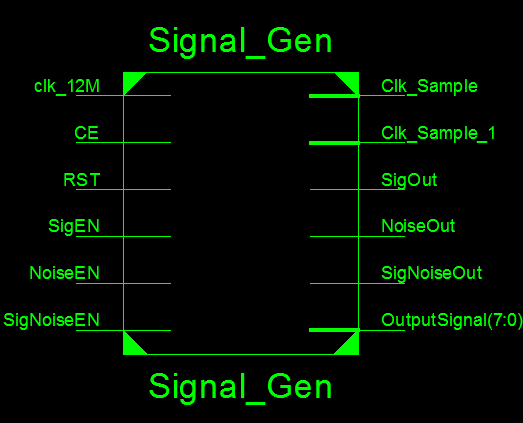
Les entrées :
- Clk_12M : Horloge système de 12 MHz
- CE : Entre de validation du circuit (Chip Select)
- RST : Entrée de réinitialisation
- SigEN : Activation du signal sinusoïdal
- NoiseEN : Activation du bruit
- SigNoiseEN : Activation du signal sinusoïdal + bruit
Les sorties :
- Clk_Sample : Horloge de l’échantillonnage (dérivée de l’horloge maitre) liée avec une LED
- Clk_Sample_1 : Equivalent à l’horloge Clk_Sample, liée avec un IO du kit de développement (signal externe peut être visualisé ou exploité pour synchroniser les échantillons de la sortie numérique
- SigOut : Indicateur de l’activation du signal sinusoïdal lié avec une LED
- NoiseOut : Indicateur de l’activation du bruit lié avec une LED
- SigNoiseOut : Indicateur de l’activation du signal sinusoïdal + bruit lié avec une LED
- OutputSignal : Signal de sortie sur 8 bits (1 échantillon sur 8 bits pour chaque coup d’horloge Clk_Sample )
Le principe du générateur des signaux est très simple ! Il est basé sur le stockage d’une période du signal sinusoïdal codée sur N bits, dans notre cas N=7 (valeurs variées de 0 à 127) de longueur 32 c.à.d. un tableau de taille 32 qui contient des valeurs qui variées de 0 à 127. Donc afin d’afficher une période du signal il faut 32 coup d’horloge !
Ex : Si on veut générer un signal sinusoïdal de fréquence F0, alors il faut que la fréquence d’échantillonnage soit 32 fois supérieure à la fréquence du signal.
Fs=N(32)*F0
Tant que le nombre des échantillons constituant le signal est important, la qualité du signal est meilleur en revanche il faut une fréquence plus rapide par rapport à la fréquence du signal. On prend comme exemple le nombre d’échantillons égal à 255 (tableau de 255 valeurs), pour obtenir un signal sinusoïdal de 1KHz il faut que la fréquence d’échantillonnage égale à 255 KHz !
Le nombre d’échantillons important induit utilisation excessif des ressources en temps et physique (horloge et mémoire).
Comment coder un signal en virgule fixe sur N bits de taille M ?
Vous pouvez en 3 ou 4 lignes de codes sur matlab passer d’un signal sinusoïdal flottant en code hexadécimal directement implémenté sur FPGA en virgule fixe. Vous pouvez choisir n’importe quel type du signal (sin, cos, sinc, bruit…). Dans ce projet on va se limiter sur deux types du signal : signal sinusoïdal et une séquence pseudo-aléatoire (un nombre limité des échantillons d’une distribution gaussienne).
Dans ce projet on va se limiter sur deux types du signal : signal sinusoïdal et une séquence pseudo-aléatoire (un nombre limité des échantillons d’une distribution gaussienne).
Le code VHDL contient trois vecteurs de 32 échantillons :
- Un vecteur du signal sinusoïdal (0-127)
- Deux vecteurs du bruit (0-15, 0-63) (bruit faible, bruit fort)
Code matlab pour générer un signal sinusoïdal
% Sin
t=linspace(0,1,32);
s_t=(sin(2*pi*t)+1)/2;
s_n=round((2^7-1)*s_t);
s_hex=dec2hex(s_n);% Bruit faible
b_t=rand(1,32);
b_n=round((2^4-1)*b_t);
b_hex=dec2hex(s_n);% Bruit fort
b_t=rand(1,32);
b_n=round((2^6-1)*b_t);
b_hex=dec2hex(s_n);
Savoir comment générer une horloge
Vous pouvez consulter le projet électronique FPGA 3 : Générateur des horloges. Le circuit permet de générer une multitude des horloges allant de 6 MHz à 1 Hz, 8 horloges en total.
Le circuit Convertisseur A/D avec le réseau R/2R
Afin de réduire la consommation du courant dans les pins de FPGA, j’ai utilisé une résistances de 4.7KR. La valeur minimale de la résistance dépend du courant max supporté par le pin IO du FPGA.
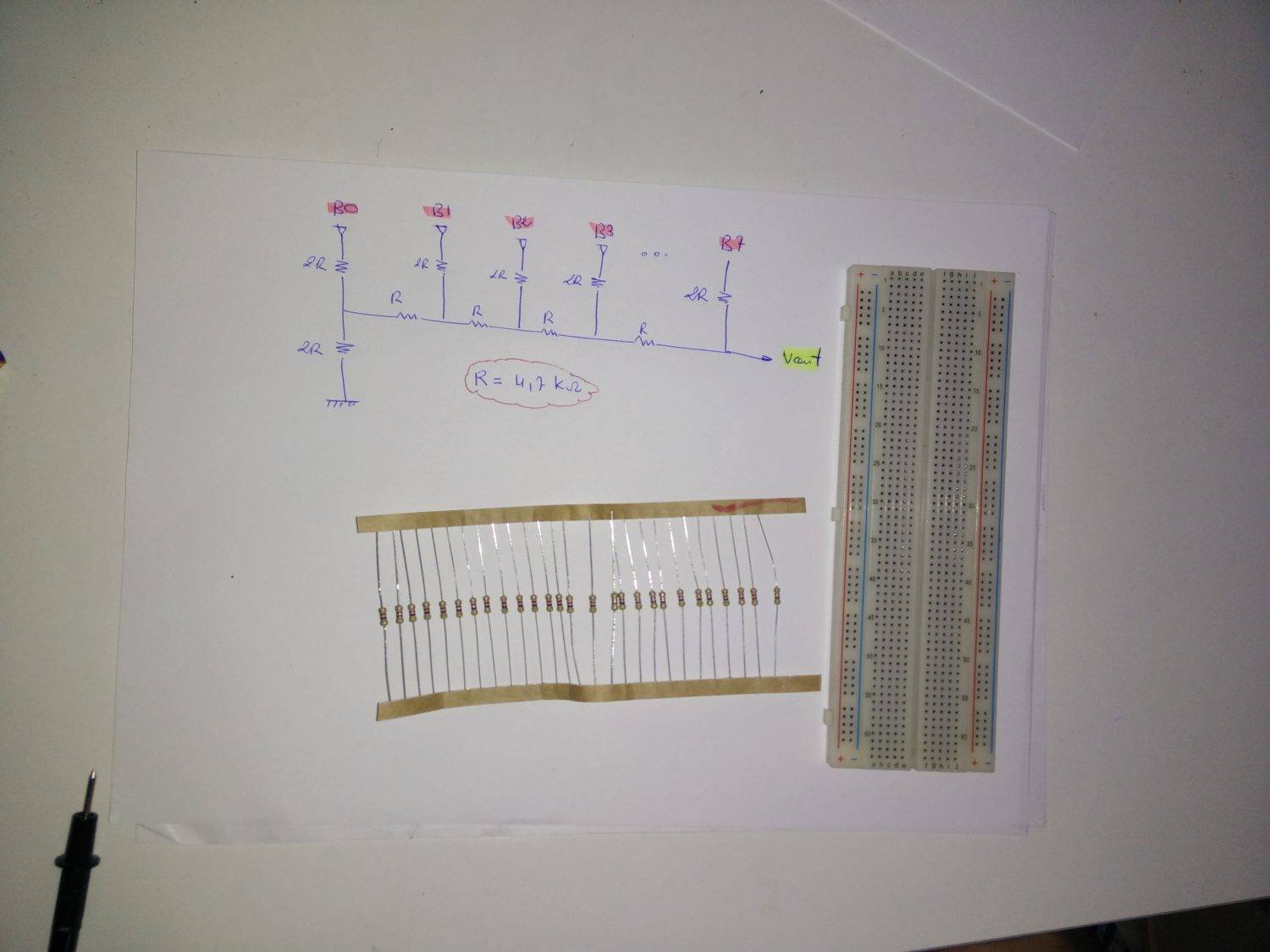
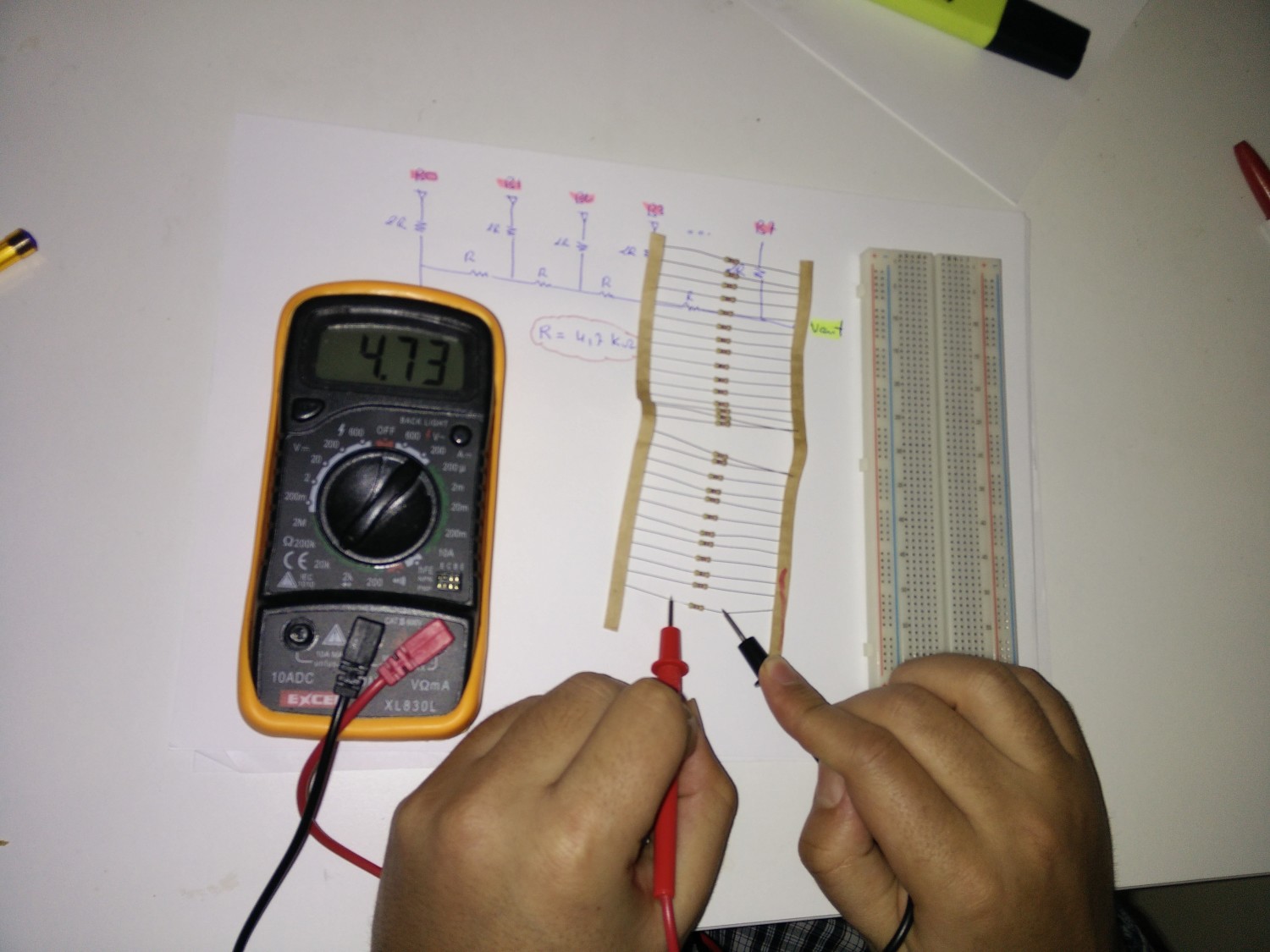
Oscilloscope numérique
Pour les personnes qui m‘ont posées la question sur l’outil de visualisation des signaux, j’utilise un oscilloscope numérique avec une câble USB de 20 MHz de bande, deux canaux. L’instrument est léger et pratique pour débuter ses projets, il est menu d’une interface graphique simple et pratique. Vous pouvez accéder à la description détaillée en cliquant sur l’image ci-dessous ou Lien direct.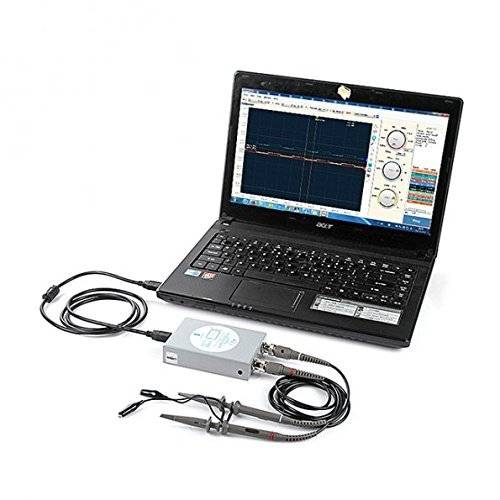
Programme FPGA
library ieee;
use ieee.std_logic_1164.all;
use ieee.std_logic_arith.all;
use ieee.std_logic_unsigned.all;
use ieee.numeric_std;
entity Signal_Gen is
Generic
(
N : positive :=24;
M : positive :=32
);
Port (
clk_12M : in STD_LOGIC;
CE : in STD_LOGIC:='0';
RST : in STD_LOGIC:='0';
Clk_Sample : out STD_LOGIC :='0';
Clk_Sample_1 : out STD_LOGIC :='0';
SigEN : in STD_LOGIC:='0';
NoiseEN : in STD_LOGIC:='0';
SigNoiseEN : in STD_LOGIC:='0';
SigOut : out STD_LOGIC:='0';
NoiseOut : out STD_LOGIC:='0';
SigNoiseOut : out STD_LOGIC:='0';
OutputSignal : out STD_LOGIC_VECTOR (7 downto 0):= x"00");
end Signal_Gen;
architecture Behavioral of Signal_Gen is
SIGNAL Count_Sample_tmp : std_logic_vector(N-1 downto 0):= x"000000";
SIGNAL Clk_Sample_tmp : std_logic:='0';
SIGNAL Signal_tmp : STD_LOGIC_VECTOR (7 downto 0);
SIGNAL Noise_tmp : STD_LOGIC_VECTOR (7 downto 0);
TYPE T_DATA is array (0 to M-1) of std_logic_vector(7 downto 0);
SIGNAL sel : std_logic_vector(7 downto 0):=x"00";
CONSTANT SIN_V : T_DATA := -- Signal sin
(x"40",
x"4C",
x"59",
x"64",
x"6E",
x"75",
x"7B",
x"7E",
x"7F",
x"7D",
x"79",
x"72",
x"69",
x"5E",
x"53",
x"46",
x"39",
x"2C",
x"21",
x"16",
x"0D",
x"06",
x"02",
x"00",
x"01",
x"04",
x"0A",
x"11",
x"1B",
x"26",
x"33",
x"3F");
--CONSTANT NOISE_V : T_DATA := -- 4 bits (bruit faible
--(x"0C",
--x"0E",
--x"02",
--x"0E",
--x"09",
--x"01",
--x"04",
--x"08",
--x"0E",
--x"0E",
--x"02",
--x"0F",
--x"0E",
--x"07",
--x"0C",
--x"02",
--x"06",
--x"0E",
--x"0C",
--x"0E",
--x"0A",
--x"01",
--x"0D",
--x"0E",
--x"0A",
--x"0B",
--x"0B",
--x"06",
--x"0A",
--x"03",
--x"0B",
--x"00");
CONSTANT NOISE_V : T_DATA := -- 6 bits (bruit fort)
(
x"10",
x"32",
x"1B",
x"39",
x"0B",
x"11",
x"09",
x"09",
x"37",
x"25",
x"23",
x"09",
x"36",
x"27",
x"16",
x"20",
x"19",
x"05",
x"0F",
x"08",
x"0C",
x"0F",
x"1A",
x"03",
x"39",
x"3C",
x"1F",
x"1F",
x"15",
x"39",
x"17",
x"07");
--CONSTANT NOISE_V : T_DATA :=( "",);
begin
-- PROCESS INDEX INCRIMENT
PROCESS (Clk_Sample_tmp,sel,RST)
BEGIN
IF RST = '1' THEN
Noise_tmp <= x"00";
ELSIF (Clk_Sample_tmp'EVENT AND Clk_Sample_tmp='1') THEN
CASE sel IS
WHEN x"00" => Noise_tmp<=NOISE_V(0); Signal_tmp<= SIN_V(0);
WHEN x"01" => Noise_tmp<=NOISE_V(1); Signal_tmp<= SIN_V(1);
WHEN x"02" => Noise_tmp<=NOISE_V(2); Signal_tmp<= SIN_V(2);
WHEN x"03" => Noise_tmp<=NOISE_V(3); Signal_tmp<= SIN_V(3);
WHEN x"04" => Noise_tmp<=NOISE_V(4); Signal_tmp<= SIN_V(4);
WHEN x"05" => Noise_tmp<=NOISE_V(5); Signal_tmp<= SIN_V(5);
WHEN x"06" => Noise_tmp<=NOISE_V(6); Signal_tmp<= SIN_V(6);
WHEN x"07" => Noise_tmp<=NOISE_V(7); Signal_tmp<= SIN_V(7);
WHEN x"08" => Noise_tmp<=NOISE_V(8); Signal_tmp<= SIN_V(8);
WHEN x"09" => Noise_tmp<=NOISE_V(9); Signal_tmp<= SIN_V(9);
WHEN x"0A" => Noise_tmp<=NOISE_V(10); Signal_tmp<= SIN_V(10);
WHEN x"0B" => Noise_tmp<=NOISE_V(11); Signal_tmp<= SIN_V(11);
WHEN x"0C" => Noise_tmp<=NOISE_V(12); Signal_tmp<= SIN_V(12);
WHEN x"0D" => Noise_tmp<=NOISE_V(13); Signal_tmp<= SIN_V(13);
WHEN x"0E" => Noise_tmp<=NOISE_V(14); Signal_tmp<= SIN_V(14);
WHEN x"0F" => Noise_tmp<=NOISE_V(15); Signal_tmp<= SIN_V(15);
WHEN x"10" => Noise_tmp<=NOISE_V(16); Signal_tmp<= SIN_V(16);
WHEN x"11" => Noise_tmp<=NOISE_V(17); Signal_tmp<= SIN_V(17);
WHEN x"12" => Noise_tmp<=NOISE_V(18); Signal_tmp<= SIN_V(18);
WHEN x"13" => Noise_tmp<=NOISE_V(19); Signal_tmp<= SIN_V(19);
WHEN x"14" => Noise_tmp<=NOISE_V(20); Signal_tmp<= SIN_V(20);
WHEN x"15" => Noise_tmp<=NOISE_V(21); Signal_tmp<= SIN_V(21);
WHEN x"16" => Noise_tmp<=NOISE_V(22); Signal_tmp<= SIN_V(22);
WHEN x"17" => Noise_tmp<=NOISE_V(23); Signal_tmp<= SIN_V(23);
WHEN x"18" => Noise_tmp<=NOISE_V(24); Signal_tmp<= SIN_V(24);
WHEN x"19" => Noise_tmp<=NOISE_V(25); Signal_tmp<= SIN_V(25);
WHEN x"1A" => Noise_tmp<=NOISE_V(26); Signal_tmp<= SIN_V(26);
WHEN x"1B" => Noise_tmp<=NOISE_V(27); Signal_tmp<= SIN_V(27);
WHEN x"1C" => Noise_tmp<=NOISE_V(28); Signal_tmp<= SIN_V(28);
WHEN x"1D" => Noise_tmp<=NOISE_V(29); Signal_tmp<= SIN_V(29);
WHEN x"1E" => Noise_tmp<=NOISE_V(30); Signal_tmp<= SIN_V(30);
WHEN x"1F" => Noise_tmp<=NOISE_V(31); Signal_tmp<= SIN_V(31);
WHEN OTHERS => Noise_tmp<=NOISE_V(0); Signal_tmp<= SIN_V(0);
END CASE ;
END IF;
END PROCESS;
-- Incrémentation chaque coup d'horloge
-- de la valeur de la sélection [Compteur de 0 à 31 ]
PROCESS (Clk_Sample_tmp, RST,CE)
BEGIN
IF RST ='1' THEN
sel <= x"00";
ELSIF (Clk_Sample_tmp'EVENT AND Clk_Sample_tmp='1') THEN
IF CE ='1' THEN
sel<= sel + 1 ;
IF sel = x"1F" THEN
sel<= x"00";
END IF ;
ELSE
sel<=sel;
END IF;
END IF ;
END PROCESS;
-- Générateur des clocks de 6 MHh ----> 11Hz
PROCESS (clk_12M, RST,CE)
BEGIN
IF RST ='1' THEN
Count_Sample_tmp <= x"000000"; --(others =>'0')
ELSIF (clk_12M'EVENT AND clk_12M='1') THEN
IF CE ='1' THEN
Count_Sample_tmp<= Count_Sample_tmp + 1 ;
ELSE
Count_Sample_tmp<=Count_Sample_tmp;
END IF;
END IF ;
END PROCESS;
-- Changez l'indice pour augmenter ou diminuer la fréquence
-- Indice varié de 0(fréquence maximale) à 23 (fréquence minimale)
-- L'horloge est une division de la fréquence maître de 6 MHz
Clk_Sample_tmp<=Count_Sample_tmp(N-10);
Clk_Sample<=Count_Sample_tmp(N-10);
Clk_Sample_1<=Count_Sample_tmp(N-10);
-- Process de sélection du type du signal
PROCESS (clk_12M, RST,SigEN,NoiseEN,SigNoiseEN)
BEGIN
IF RST ='1' THEN
SigOut <='0';
NoiseOut <='0';
SigNoiseOut <='0';
OutputSignal<=x"00";
ELSIF (clk_12M'EVENT AND clk_12M='1') THEN
IF SigEN ='1' THEN
SigOut <='1';
NoiseOut <='0';
SigNoiseOut <='0';
OutputSignal<=Signal_tmp;
ELSIF NoiseEN ='1' THEN
SigOut <='0';
NoiseOut <='1';
SigNoiseOut <='0';
OutputSignal<=Noise_tmp;
ELSIF SigNoiseEN ='1' THEN
SigOut <='0';
NoiseOut <='0';
SigNoiseOut <='1';
OutputSignal<= Signal_tmp + Noise_tmp;
ELSE
SigOut<='0';
NoiseOut <='0';
SigNoiseOut <='0';
OutputSignal<=x"00";
END IF;
END IF ;
END PROCESS;
end Behavioral;
Contenue du fichier ucf (Pinout)
CONFIG VCCAUX = "3.3" ;
# Clock 12 MHz
NET "clk_12M" LOC = P129 | IOSTANDARD = LVCMOS33 | PERIOD = 12MHz;
# Inputs DIP Swithch
NET "CE" LOC = P70 | PULLUP | IOSTANDARD = LVCMOS33 | SLEW = SLOW | DRIVE = 12;
NET "RST" LOC = P69 | PULLUP | IOSTANDARD = LVCMOS33 | SLEW = SLOW | DRIVE = 12;
NET "SigEN" LOC = P68 | PULLUP | IOSTANDARD = LVCMOS33 | SLEW = SLOW | DRIVE = 12;
NET "NoiseEN" LOC = P64 | PULLUP | IOSTANDARD = LVCMOS33 | SLEW = SLOW | DRIVE = 12;
NET "SigNoiseEN" LOC = P63 | PULLUP | IOSTANDARD = LVCMOS33 | SLEW = SLOW | DRIVE = 12;
# Outputs LED
NET "SigOut" LOC = P46 | IOSTANDARD = LVCMOS33 | SLEW = SLOW | DRIVE = 12;
NET "NoiseOut" LOC = P47 | IOSTANDARD = LVCMOS33 | SLEW = SLOW | DRIVE = 12;
NET "SigNoiseOut" LOC = P48 | IOSTANDARD = LVCMOS33 | SLEW = SLOW | DRIVE = 12;
NET "Clk_Sample" LOC = P55 | IOSTANDARD = LVCMOS33 | SLEW = SLOW | DRIVE = 12;
# Output Signal
NET "OutputSignal[0]" LOC = P31 | IOSTANDARD = LVCMOS33 | SLEW = SLOW | DRIVE = 12;
NET "OutputSignal[1]" LOC = P32 | IOSTANDARD = LVCMOS33 | SLEW = SLOW | DRIVE = 12;
NET "OutputSignal[2]" LOC = P28 | IOSTANDARD = LVCMOS33 | SLEW = SLOW | DRIVE = 12;
NET "OutputSignal[3]" LOC = P30 | IOSTANDARD = LVCMOS33 | SLEW = SLOW | DRIVE = 12;
NET "OutputSignal[4]" LOC = P27 | IOSTANDARD = LVCMOS33 | SLEW = SLOW | DRIVE = 12;
NET "OutputSignal[5]" LOC = P29 | IOSTANDARD = LVCMOS33 | SLEW = SLOW | DRIVE = 12;
NET "OutputSignal[6]" LOC = P24 | IOSTANDARD = LVCMOS33 | SLEW = SLOW | DRIVE = 12;
NET "OutputSignal[7]" LOC = P25 | IOSTANDARD = LVCMOS33 | SLEW = SLOW | DRIVE = 12;
# Clock
NET "Clk_Sample_1" LOC = P19 | IOSTANDARD = LVCMOS33 | SLEW = SLOW | DRIVE = 12;
Photos du projet
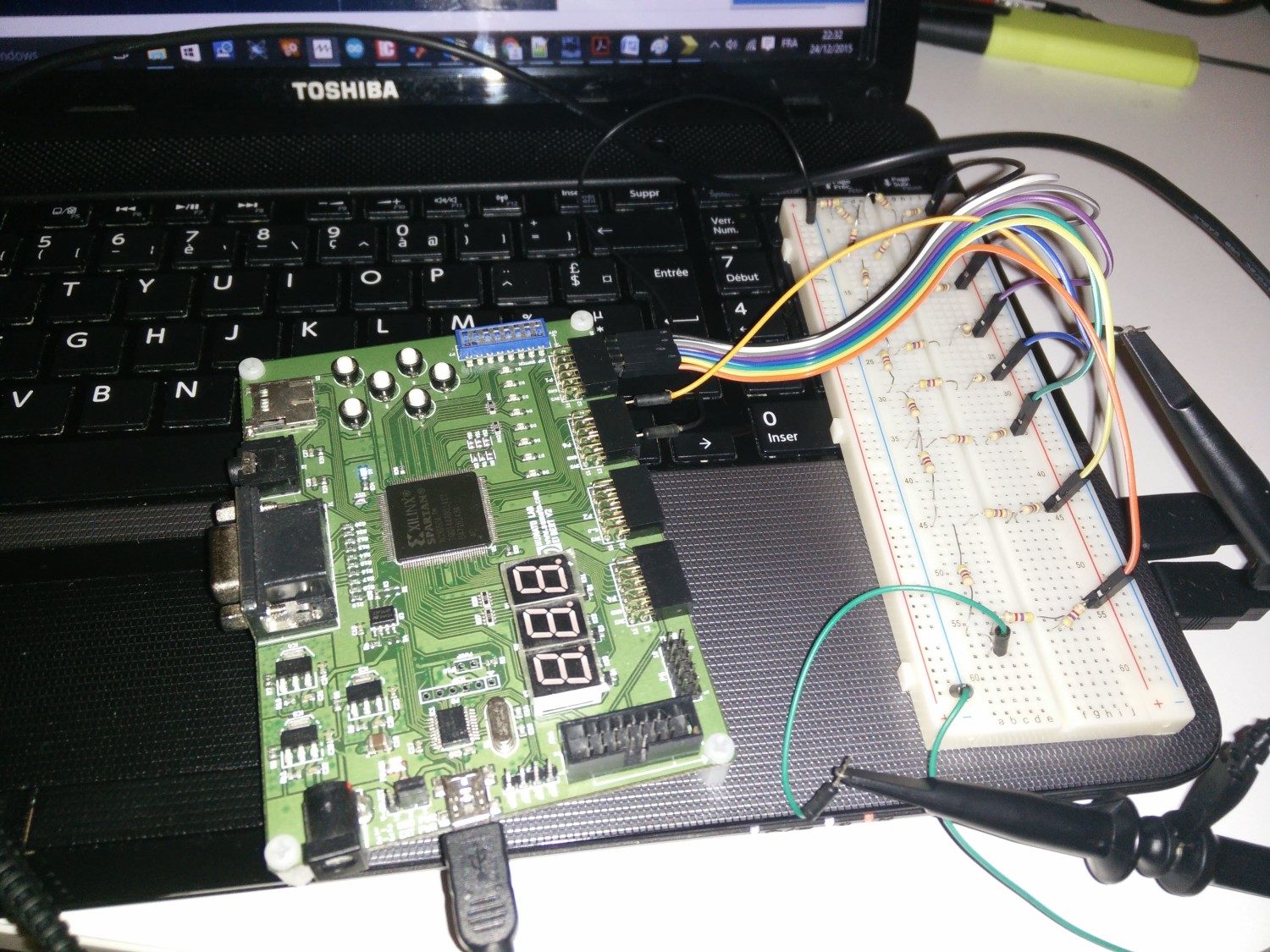

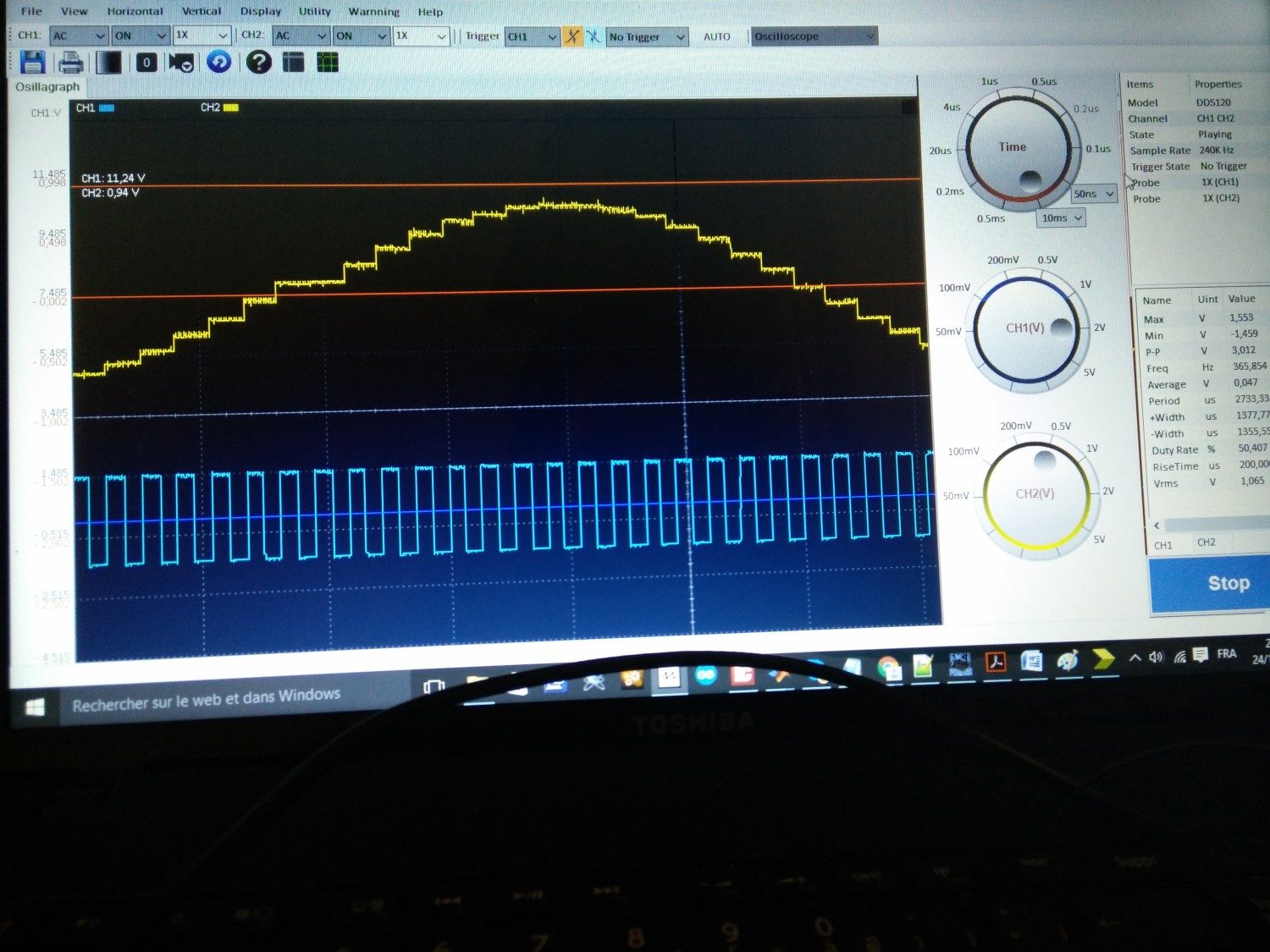
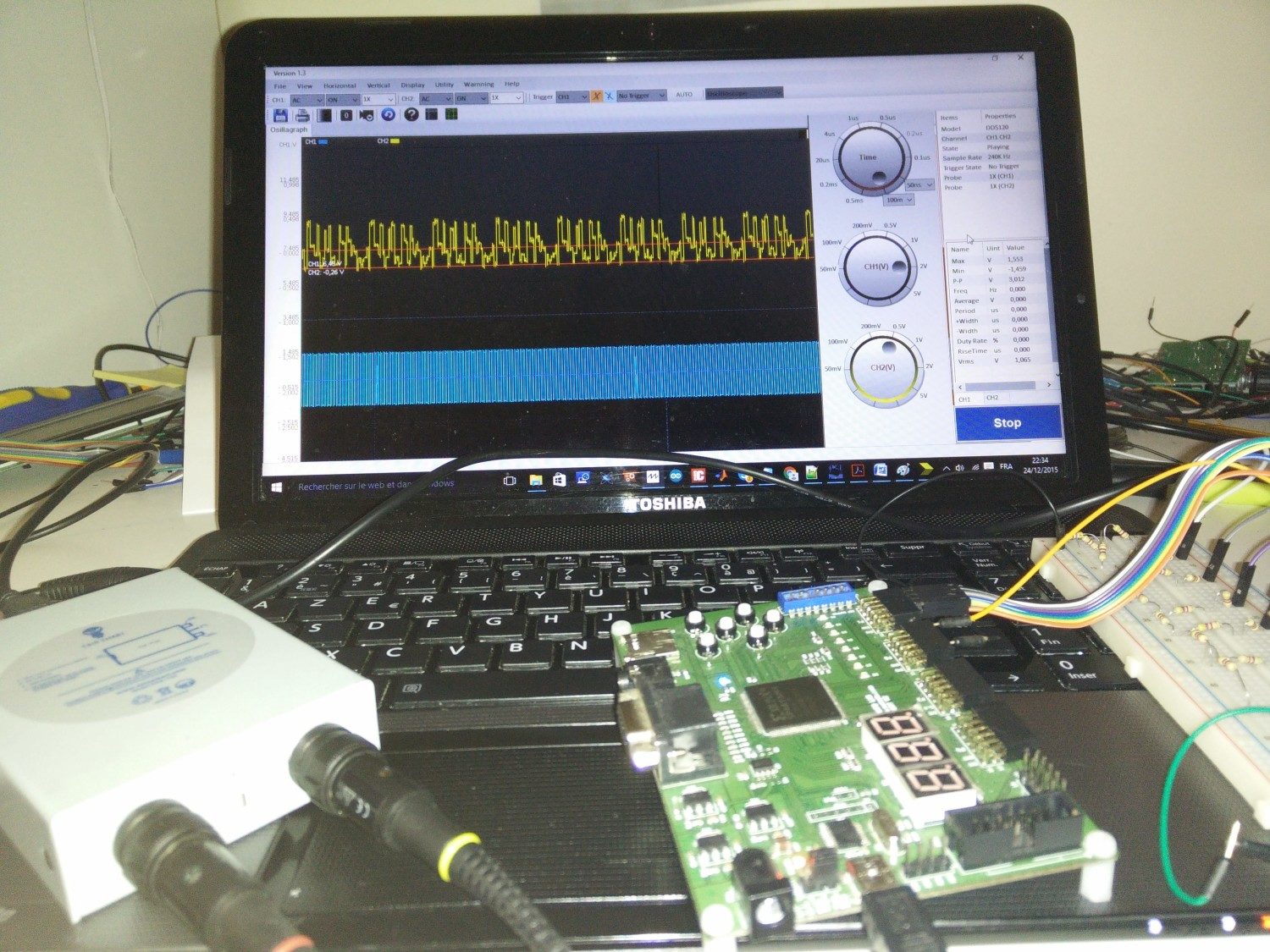
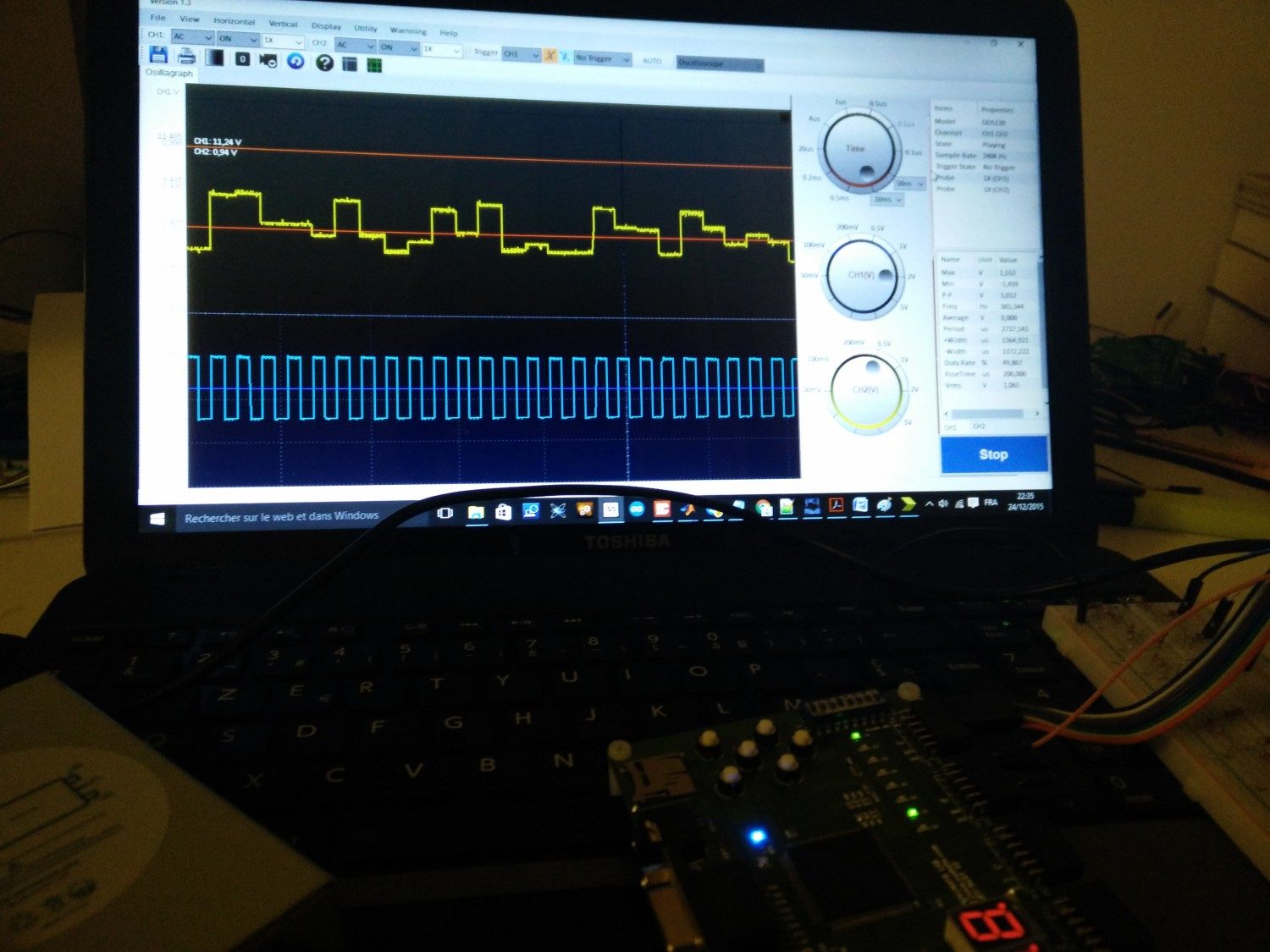
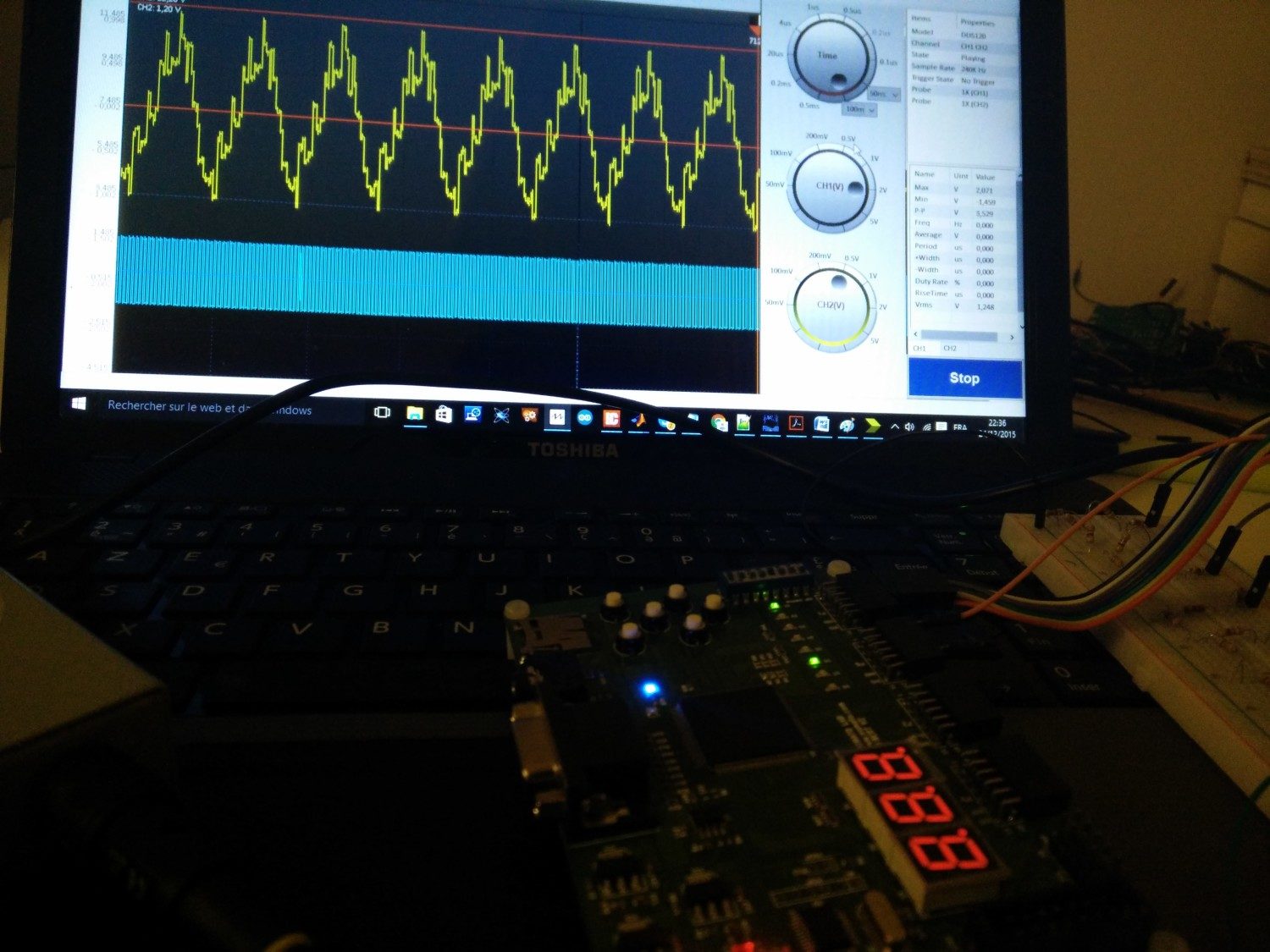
************
Un petit commentaire de vous, un Grand encouragement pour nous 🙂
************

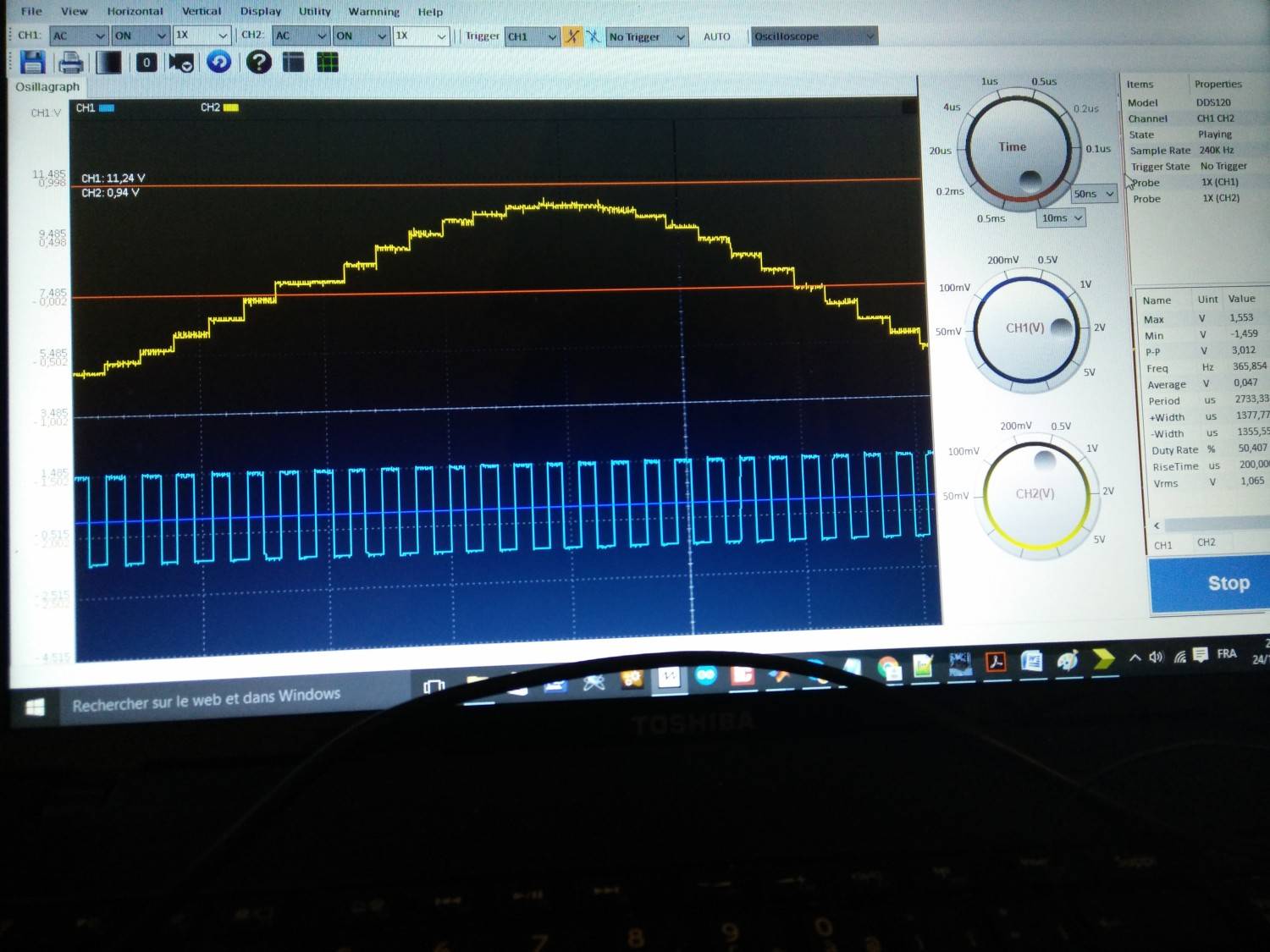
Une réponse sur « Projet électronique FPGA #5 : Générateur des signaux #V1 »
[…] Voir le projet pour plus des détails : Projet électronique FPGA #5 : Générateur des signaux #V1 […]